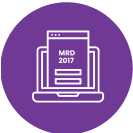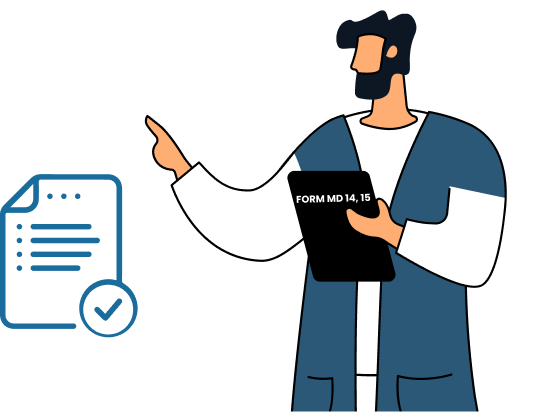Permission for Loan License to Manufacture Class A & B In- Vitro Diagnostics in India - Form MD4 & MD6

At CliniExperts, our team remains abreast of the latest requirements set by authorities. This ensures meticulous documentation, prompt application processing, and swift approvals. We offer comprehensive solutions for your IVD product requirements. This covers test and manufacturing licenses, along with post-marketing licenses.
Permission for Loan License to Manufacture Class A & B In- Vitro Diagnostics (Form MD 4, 6) – Overview
For manufacturing an in-vitro medical device of Class A & B, a loan license must be taken before manufacturing it at a site of another licensee. Any manufacturer who intends to produce a device can apply to the concerned State Licensing Authority. A manufacturer has to go through an online application process for the medical device under the standards laid down by the CDSCO. The process involves filling out the application form MD-4 on the online portal of the Ministry of Health and Family Welfare.
After evaluating the data, the State Licensing Authority can accept/reject the submitted proposal. The acceptance of the Loan Manufacturing License will be given by Form MD-6. The overall process takes about two to three months after applying.

Who Can Apply?
Any manufacturer who wants to manufacture a Class A or Class B IVD can apply for the Loan License to manufacture intended for sale or distribution.
How To Apply?
The Applicant must follow the following process:
-

Filing an application under Form MD-4 to the State Licensing Authority. The form has to be submitted on the SUGAM online portal.
-

Submission of all necessary documents.
-

Payment of fees.

Validity
The validity of an approved Loan Manufacturing License is five years.

Fee Involved
The application for approval of one site manufacturing costs about INR 50000 and INR 1000 for each specific medical device.Important Documents

A specific set of documents are required for the approval which includes:
- A Plant Master File
- The Device Master file, along with description and intended use
- The device labels and IFU
- The Quality Management System ISO 13485 certificate
- The details of the firm constitution
- The details of the manufacturing site establishment/site ownership/ tenancy agreement
Timeline to get
MD6
from Central Drugs Standard Control Organisation
2 to 3
MONTHSEssential Tips
- The site selected for loan manufacturing must hold a license for producing medical devices of an equivalent or higher class.
- A test license should be acquired under Form MD-13 before applying for the loan license.
- Before applying for a loan license to manufacture Class A and Class B IVD, verification and validation study reports are required.
- If an application is rejected by the SLA after document scrutiny, the reasons for rejection will be provided in writing. This will be done within 45 days of the application date.
- The standards of the manufacturing site should comply with the standards of the QMS as per the Fifth Schedule.
- As per the Medical Devices Rule, 2017 (Third Schedule), there can be an audit by the SLA of the manufacturing site after the application is submitted.
Expert Advise
For the approval of Loan license, an applicant must have the test license to manufacture small quantity IVDs.
Related Services
SUGAM Registration- MD/ IVD
Importer | Regulatory Body: CDSCO
The registration process includes several steps to obtain approvals. The process involves registration, undertaking, and uploading the documents, complying with the given rules and regulations. We at CliniExperts, make sure that our expert team creates your registration easy and quick so that you can focus on more important aspects of your product launch...
Test license to manufacture In Vitro Diagnostics in India – MD 12 & MD 13
Manufacturers | Regulatory Body: CDSCO
Registration for in-vitro diagnostic medical devices for manufacturing can be time-consuming and tedious; we at CliniExperts will take care of all the registration procedures while you focus energies on planning your product launch. From the application process forms to undertaking a license test, we assist in every registration aspect to help you smoothly start the manufacturing process.
Import License For In-Vitro Diagnostic Kits in India – Form MD14 & MD15
Importers | Regulatory Body: CDSCO
Get Your Import License for In-Vitro Diagnostic Kits (IVD) and Medical Devices with CliniExperts. Hassle-free assistance in providing Import License of Form MD 15.
Frequently Asked Questions
Will there be a site inspection of the IVD Manufacturing site before granting the license?
Audit of the manufacturing site is not necessary for Class A IVDs. The grant or loan license to manufacture for sale or distribution can be given to such a category without a prior site inspection. However, Class B, Class C, and Class D IVDs require the manufacturing site inspection before the license grant.

What do you mean by“manufacturing under the Loan License”?
A loan license is a license given to a manufacturer which states the approval of manufacturing a medical device on a manufacturing site of another licensee; this includes using the manufacturing site of a different manufacturer to produce the same medical device. The loan license is given by the State Licensing Authority or by the Central Licensing Authority.

Is it necessary to conduct PER on the test batches of manufactured IVD before introducing them in the market? How many batch samplesare required for PER, and where do the batch samples need to be sent?
Yes, a PER is necessary before introducing the product in the market; for conducting the PER, an applicant must obtain a License in Form-29 when developing three or more trial batches of the IVD product. The prescribed number of samples from three consecutive batches of IVD products have to be sent to NIB (NOIDA) or any other notified laboratory. The PER test should be submitted to CDSCO and the concerned State Drugs Control Authority.

What are the requirements for maintaining an IVD master file?
The applicant has to maintain the master file for each medical device. A detailed outline and contents have been stated in appendix – II of the Fourth Schedule.

What is an In-Vitro Diagnostic (IVD)?
In-Vitro Diagnostic devices are intended to be used outside the human or animal body. This device aims to diagnose a disease or disorder in human beings or animals. Under the Drugs and Cosmetics Act, 1940, these devices are under section 3 of sub-clause (i) of clause (b). The IVD devices are updated with recent changes, as per the Drugs and Cosmetics Act, 1940 under clause (b) of sub-clause (iv).

